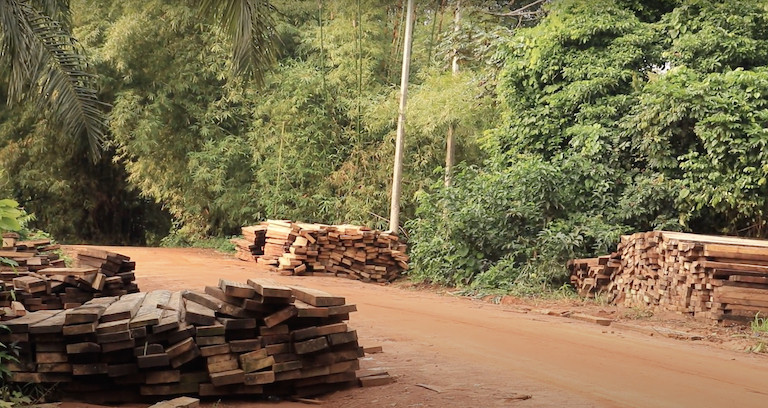Forests & Finance: Cameroon raw log ban expands and villagers act against ‘forest bandits’
Forests & Finance: Cameroon raw log ban expands and villagers act ... Mongabay.com


Cameroon expands limits on raw log exports
YAOUNDE — Cameroon’s Ministry of Forestry and Wildlife (MINFOF) has expanded the list of tree species that can no longer be exported from the Central African country as raw logs. Along with other Congo Basin countries, Cameroon is moving toward a complete ban on exports of unprocessed timber, which is now expected to come into force in January 2026.
In 2018, the ministry banned raw log exports of 31 species. A June directive from MINFOF lists 45 additional species, including commercially-prized ones like moabi (Bailonella toxisperma) and okoume (Aucoumea klaineana), that will now have to be processed inside Cameroon before export to markets in the EU or Asia. The list will expand again in 2025, the ministry says, closing the door to raw log exports on all but seven timber types.

A complete ban on raw log exports, intended to stimulate the development of domestic timber processing and retain a greater share of the value of timber exports, was originally scheduled for January 2022. Cameroon and its neighbours have postponed adoption of the ban several times, saying their domestic timber sectors are not yet ready to process wood on the scale needed.
Andre Bekolo Nka, who heads MINFOF’s work in the Boumba and Ngoko division of Cameroon’s East region, told Mongabay that the main species currently exploited in the forest there include padouk (Pterocarpus soyauxii), used extensively for construction, and sapelli (Entandrophragma cylindricum), valued for its quality timber, as well as an edible caterpillar that feeds on it.
Nka told Mongabay that since the early 2000s, every company with a permit to harvest timber in his division also has a processing plant, and 70% of trees legally felled in Boumba and Ngoko are processed locally. He said 30% of the division’s timber is destined for export, including substantial amounts of trees only recently targeted here, such as the durable hardwood tali (Erythrophleum suaveolens) and ayous (Triplochiton scleroxylon). “With the imminent end to raw log exports, awareness is being raised, and sawn timber, in this case, ayous, is being piled up on site,” he said.
Nka said banning raw log exports needs to be accompanied by revised policy to encourage loggers to maximize processing of trees they cut down, recovering wood for local consumption that’s currently thrown away.
“The total ban on exporting logs should call for a paradigm shift in the management of our forests. We should no longer limit ourselves to harvesting logs alone but also recover the large branches that can be processed,” he told Mongabay.

Nigerian villagers
SDGs, Targets, and Indicators Analysis
1. Which SDGs are addressed or connected to the issues highlighted in the article?
- SDG 15: Life on Land – The article discusses the efforts to protect forests and biodiversity from illegal logging in Cameroon and Nigeria.
- SDG 12: Responsible Consumption and Production – The article mentions the ban on raw log exports in Cameroon, which aims to stimulate domestic timber processing and retain more value from timber exports.
2. What specific targets under those SDGs can be identified based on the article’s content?
- SDG 15.2: By 2020, promote the implementation of sustainable management of all types of forests, halt deforestation, restore degraded forests, and substantially increase afforestation and reforestation globally – The efforts to protect forests and biodiversity from illegal logging in Nigeria align with this target.
- SDG 12.2: By 2030, achieve the sustainable management and efficient use of natural resources – The ban on raw log exports in Cameroon aims to promote the sustainable management and processing of timber resources.
3. Are there any indicators mentioned or implied in the article that can be used to measure progress towards the identified targets?
- Indicator for SDG 15.2: Forest area as a proportion of total land area – The progress towards halting deforestation and promoting sustainable forest management can be measured by monitoring changes in forest area.
- Indicator for SDG 12.2: Domestic material consumption per capita – The progress towards achieving sustainable management and efficient use of natural resources can be measured by monitoring changes in domestic material consumption per capita.
Table: SDGs, Targets, and Indicators
| SDGs | Targets | Indicators |
|---|---|---|
| SDG 15: Life on Land | Target 15.2: By 2020, promote the implementation of sustainable management of all types of forests, halt deforestation, restore degraded forests, and substantially increase afforestation and reforestation globally | Indicator: Forest area as a proportion of total land area |
| SDG 12: Responsible Consumption and Production | Target 12.2: By 2030, achieve the sustainable management and efficient use of natural resources | Indicator: Domestic material consumption per capita |
Behold! This splendid article springs forth from the wellspring of knowledge, shaped by a wondrous proprietary AI technology that delved into a vast ocean of data, illuminating the path towards the Sustainable Development Goals. Remember that all rights are reserved by SDG Investors LLC, empowering us to champion progress together.
Source: news.mongabay.com

Join us, as fellow seekers of change, on a transformative journey at https://sdgtalks.ai/welcome, where you can become a member and actively contribute to shaping a brighter future.







